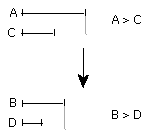If a first magnitude have to a second the same ratio as a third has to a fourth, and the first be greater than the third, the second will also be greater than the fourth; if equal, equal; and if less, less.
 For let a first magnitude A have the same ratio to a second B as a third C has
to a fourth D;
For let a first magnitude A have the same ratio to a second B as a third C has
to a fourth D;
 and let A be greater than C;I say that B is also greater than D.
and let A be greater than C;I say that B is also greater than D.
 For, since A is greater than C,
For, since A is greater than C,
 and B is another, chance, magnitude, therefore A has to B a greater ratio than
C has to B.
and B is another, chance, magnitude, therefore A has to B a greater ratio than
C has to B.
 But, as A is to B, so is C to D; therefore C has also to D a greater ratio
than C has to B.
But, as A is to B, so is C to D; therefore C has also to D a greater ratio
than C has to B.
 But that to which the same has a greater ratio is less; therefore D
is less than B;
But that to which the same has a greater ratio is less; therefore D
is less than B;
 so that B is greater than D.
so that B is greater than D.
Similarly we can prove that, if A be equal to C, B will also be equal to D;
and, if A be less than C, B will also be less than D.
Therefore etc.
Q.E.D